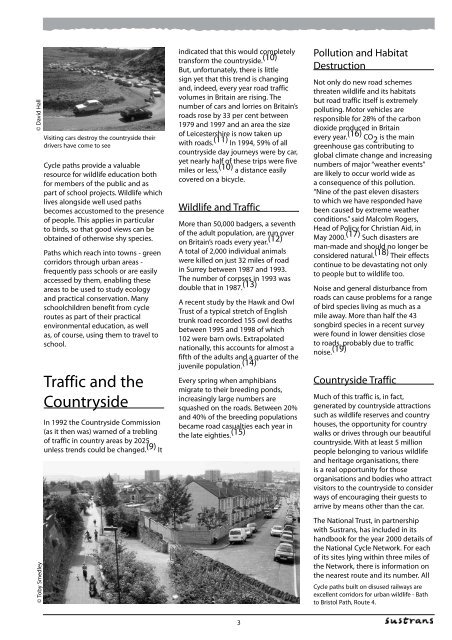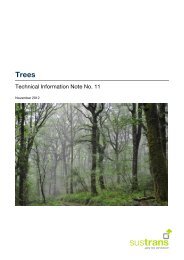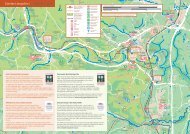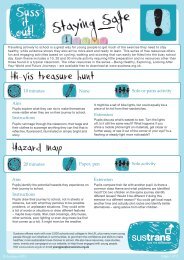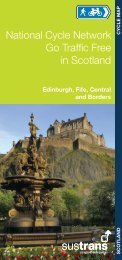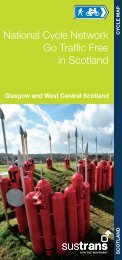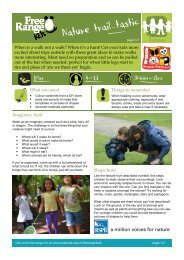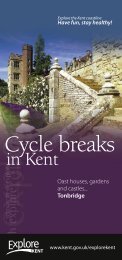Biodiversity Action Plan for the National Cycle Network ... - Sustrans
Biodiversity Action Plan for the National Cycle Network ... - Sustrans
Biodiversity Action Plan for the National Cycle Network ... - Sustrans
You also want an ePaper? Increase the reach of your titles
YUMPU automatically turns print PDFs into web optimized ePapers that Google loves.
© David Hall<br />
© Toby Smedley<br />
Visiting cars destroy <strong>the</strong> countryside <strong>the</strong>ir<br />
drivers have come to see<br />
<strong>Cycle</strong> paths provide a valuable<br />
resource <strong>for</strong> wildlife education both<br />
<strong>for</strong> members of <strong>the</strong> public and as<br />
part of school projects. Wildlife which<br />
lives alongside well used paths<br />
becomes accustomed to <strong>the</strong> presence<br />
of people. This applies in particular<br />
to birds, so that good views can be<br />
obtained of o<strong>the</strong>rwise shy species.<br />
Paths which reach into towns - green<br />
corridors through urban areas -<br />
frequently pass schools or are easily<br />
accessed by <strong>the</strong>m, enabling <strong>the</strong>se<br />
areas to be used to study ecology<br />
and practical conservation. Many<br />
schoolchildren benefit from cycle<br />
routes as part of <strong>the</strong>ir practical<br />
environmental education, as well<br />
as, of course, using <strong>the</strong>m to travel to<br />
school.<br />
Traffic and <strong>the</strong><br />
Countryside<br />
In 1992 <strong>the</strong> Countryside Commission<br />
(as it <strong>the</strong>n was) warned of a trebling<br />
of traffic in country areas by 2025<br />
unless trends could be changed. (9) It<br />
indicated that this would completely<br />
trans<strong>for</strong>m <strong>the</strong> countryside. (10)<br />
But, un<strong>for</strong>tunately, <strong>the</strong>re is little<br />
sign yet that this trend is changing<br />
and, indeed, every year road traffic<br />
volumes in Britain are rising. The<br />
number of cars and lorries on Britain’s<br />
roads rose by 33 per cent between<br />
1979 and 1997 and an area <strong>the</strong> size<br />
of Leicestershire is now taken up<br />
with roads. (11) In 1994, 59% of all<br />
countryside day journeys were by car,<br />
yet nearly half of <strong>the</strong>se trips were five<br />
miles or less, (10) a distance easily<br />
covered on a bicycle.<br />
Wildlife and Traffic<br />
More than 50,000 badgers, a seventh<br />
of <strong>the</strong> adult population, are run over<br />
on Britain’s roads every year. (12)<br />
A total of 2,000 individual animals<br />
were killed on just 32 miles of road<br />
in Surrey between 1987 and 1993.<br />
The number of corpses in 1993 was<br />
double that in 1987. (13)<br />
A recent study by <strong>the</strong> Hawk and Owl<br />
Trust of a typical stretch of English<br />
trunk road recorded 155 owl deaths<br />
between 1995 and 1998 of which<br />
102 were barn owls. Extrapolated<br />
nationally, this accounts <strong>for</strong> almost a<br />
fifth of <strong>the</strong> adults and a quarter of <strong>the</strong><br />
juvenile population. (14)<br />
Every spring when amphibians<br />
migrate to <strong>the</strong>ir breeding ponds,<br />
increasingly large numbers are<br />
squashed on <strong>the</strong> roads. Between 20%<br />
and 40% of <strong>the</strong> breeding populations<br />
became road casualties each year in<br />
<strong>the</strong> late eighties. (15)<br />
Pollution and Habitat<br />
Destruction<br />
Not only do new road schemes<br />
threaten wildlife and its habitats<br />
but road traffic itself is extremely<br />
polluting. Motor vehicles are<br />
responsible <strong>for</strong> 28% of <strong>the</strong> carbon<br />
dioxide produced in Britain<br />
every year. (16) CO 2 is <strong>the</strong> main<br />
greenhouse gas contributing to<br />
global climate change and increasing<br />
numbers of major “wea<strong>the</strong>r events”<br />
are likely to occur world wide as<br />
a consequence of this pollution.<br />
“Nine of <strong>the</strong> past eleven disasters<br />
to which we have responded have<br />
been caused by extreme wea<strong>the</strong>r<br />
conditions.” said Malcolm Rogers,<br />
Head of Policy <strong>for</strong> Christian Aid, in<br />
May 2000. (17) Such disasters are<br />
man-made and should no longer be<br />
considered natural. (18) Their effects<br />
continue to be devastating not only<br />
to people but to wildlife too.<br />
Noise and general disturbance from<br />
roads can cause problems <strong>for</strong> a range<br />
of bird species living as much as a<br />
mile away. More than half <strong>the</strong> 43<br />
songbird species in a recent survey<br />
were found in lower densities close<br />
to roads, probably due to traffic<br />
noise. (19)<br />
Countryside Traffic<br />
Much of this traffic is, in fact,<br />
generated by countryside attractions<br />
such as wildlife reserves and country<br />
houses, <strong>the</strong> opportunity <strong>for</strong> country<br />
walks or drives through our beautiful<br />
countryside. With at least 5 million<br />
people belonging to various wildlife<br />
and heritage organisations, <strong>the</strong>re<br />
is a real opportunity <strong>for</strong> those<br />
organisations and bodies who attract<br />
visitors to <strong>the</strong> countryside to consider<br />
ways of encouraging <strong>the</strong>ir guests to<br />
arrive by means o<strong>the</strong>r than <strong>the</strong> car.<br />
The <strong>National</strong> Trust, in partnership<br />
with <strong>Sustrans</strong>, has included in its<br />
handbook <strong>for</strong> <strong>the</strong> year 2000 details of<br />
<strong>the</strong> <strong>National</strong> <strong>Cycle</strong> <strong>Network</strong>. For each<br />
of its sites lying within three miles of<br />
<strong>the</strong> <strong>Network</strong>, <strong>the</strong>re is in<strong>for</strong>mation on<br />
<strong>the</strong> nearest route and its number. All<br />
<strong>Cycle</strong> paths built on disused railways are<br />
excellent corridors <strong>for</strong> urban wildlife - Bath<br />
to Bristol Path, Route 4.<br />
3


